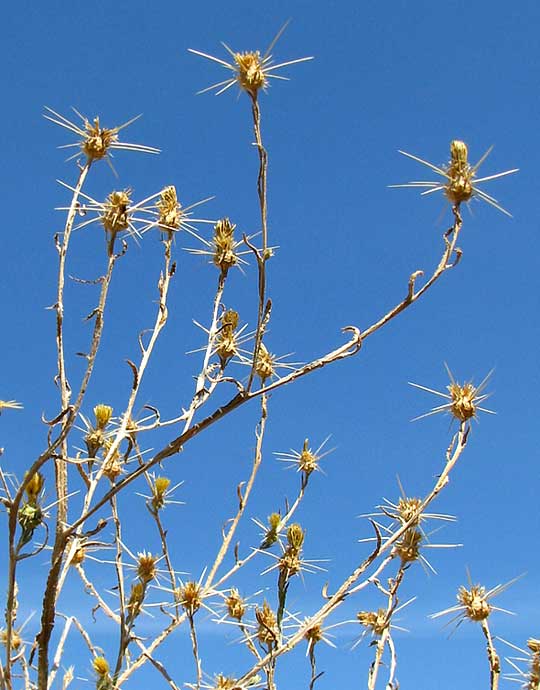Excerpts from Jim Conrad's
Naturalist Newsletter
from the September 27, 2009 Newsletter, issued from the Siskiyou Mountains west of Grants Pass, Oregon:
YELLOW STARTHISTLE
When I plopped onto the sandbank on which the pretty Soapwort lived, I managed to sit right atop a knocked-down Yellow Starthistle, CENTAUREA SOLSTITIALIS. You can see why that turned out to be so disagreeable below:

A close-up of an inch-high starthistle flower head is shown below:

To understand what the last picture shows, first keep in mind that starthistles are members of the Sunflower or Composite Family, so the whole thing in the picture is a flower head, not a single flower. The yellow items issuing from the spiny sphere's top are the flowers, many slender ones crammed together as in a vase. Remember that composite-flower flower heads are set upon a table-like platform, the receptacle, which is subtended by a cuplike collection of many scale-like bracts (modified leaves), which usually are tough, greenish and overlapping, like shingles on a roof. These "involucral bracts" are also known as phyllaries. Last week we saw how the phyllaries of Pearly Everlasting flowers were spectacularly white, papery and widely flaring, so this week we're seeing how each phyllary can bear big, forking spines.
Starthistles also are invasive, native to the Mediterranean region. You can imagine what they can do to an animal's mouth or stomach, and to top that off they're even poisonous to horses, causing the nervous disorder "chewing disease". Sometimes you see large areas of pure populations of them. One reason is that they've left their natural predators back in the Mediterranean region, but another is that they produce "allelochemicals" which prevent the growth of other plant species. There's more about allelochemicals at http://www.encyclopedia.com/doc/1O6-allelochemical.html.
Yellow Starthistles now occur throughout the US except in some Southeastern and far Northeastern states.